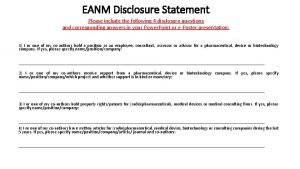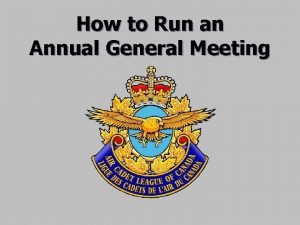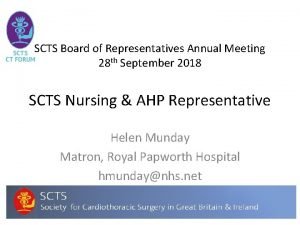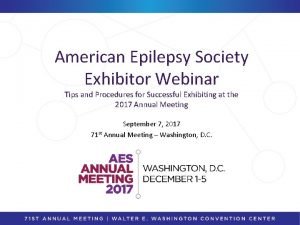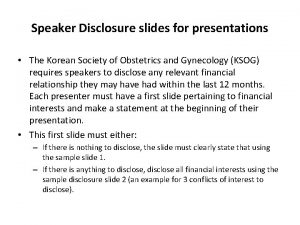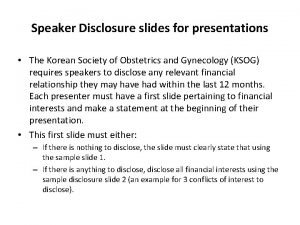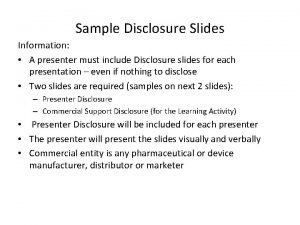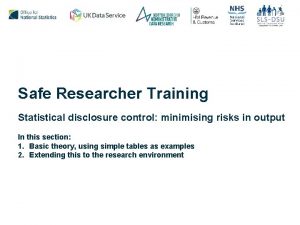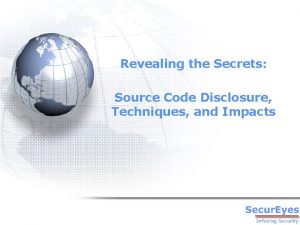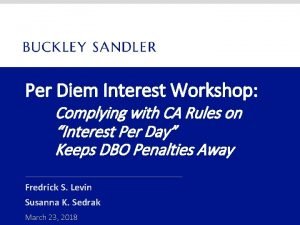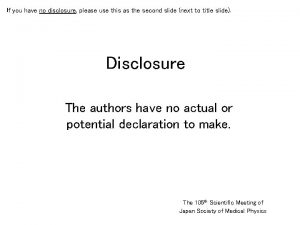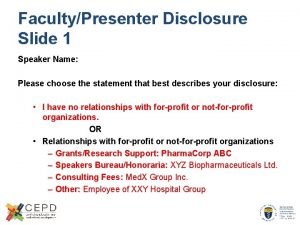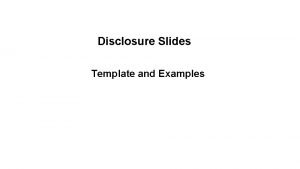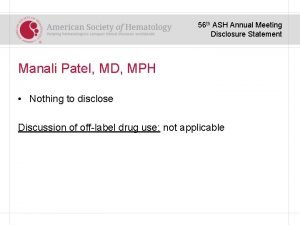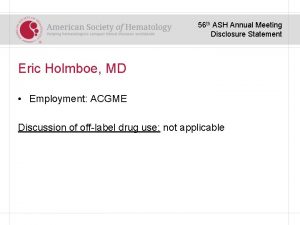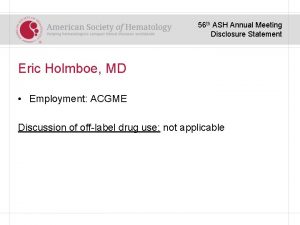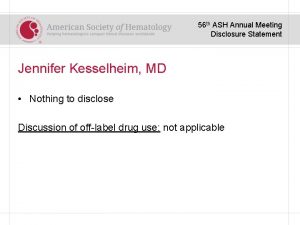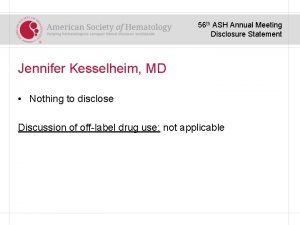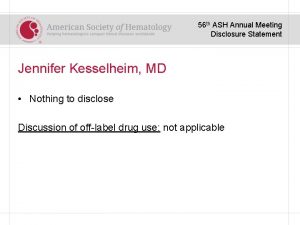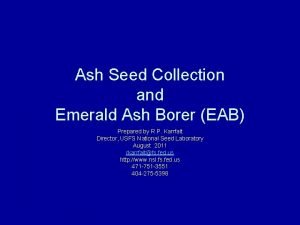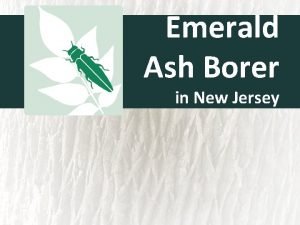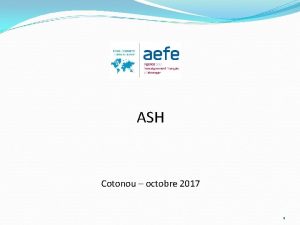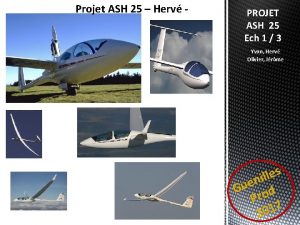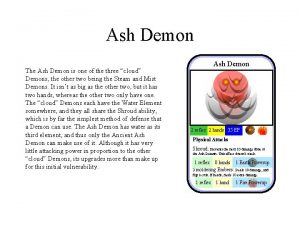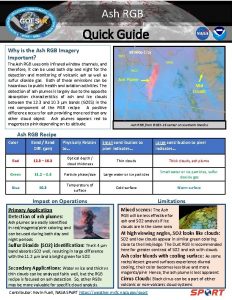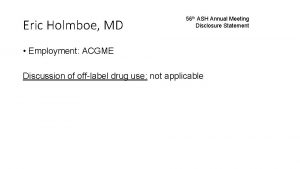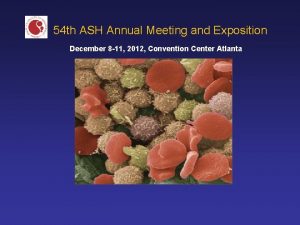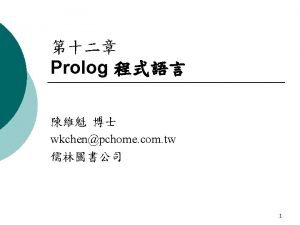56 th ASH Annual Meeting Disclosure Statement Gary































- Slides: 31

56 th ASH Annual Meeting Disclosure Statement Gary Schiller, MD • Nothing to disclose Discussion of off-label drug use: not applicable

How to Teach Recommendations for Reaching an Audience and Communicating

The Objectives of Teaching in a Medical Environment • To communicate an idea – Introduction of a new concept • Pathophysiology, Diagnostic, Pharmacology • To develop a skill – Introduction of a procedural, technical skill • Radiological, Surgical, Diagnostic

Establishing Objectives • Determining, a priori, the objectives of the presentation • Developing a general set of objectives • Developing a specific set of objectives • Considering methods to test the success of the teaching method

Technical Methods of Teaching • • • Didactic lectures Small-group presentations Programmed approaches Interactive web-based approaches Written material – Articles, Reviews, Chapters, Books

Mastery of the Topic • Preparation requires – Appropriate reference materials – A large bibliography – An outline – A set of objectives – A set of tools to determine the outcome of the educational intervention

The Nature of Communication • Direct – Lectures, Small-group presentations, Tutorials • Indirect – Manuscripts, Abstracts, Posters, Web-based systems

The Nature of Direct Communication • Projection • Reflection • Confrontation • Empathy • Distance

The Nature of Indirect Communication • Formal stylistic rules of presentation – Manuscripts: Introduction, Methods, Results, Discussion, Conclusion – Reviews: History, Pathophysiology, Histology, Natural History, Treatment, Future Directions – Books: follow the same patterns as Reviews – Programmed approaches

Specific Tips for Direct Communication • • • Know your audience Understand the topic thoroughly Know where you are going Repetition Identify the purpose to your conclusion

Further Tips for Lectures, Oral Presentations • Do not rely on technology – Know the topic well enough to speak without props – Never read from slides – Never read a prepared text, unless you have a teleprompter – Minimize text

Further Tips for Lectures, Oral Presentations • • • Never initiate a lecture with an apology The purpose of jokes Try not to hide behind a podium Engage the audience Finish early, with time for questions

Specific Tips for Written Communication • Establish the distinctiveness of your presentation • Make the most general statements in the introduction • Make the most arcane statements in the results • Clarify your results in the discussion

Further Tips for Poster Presentations • Minimize the amount of text • Establish the distinctiveness of your presentation in bullet points • Clarify the obscure points of your methods • Highlight results • Avoid a written discussion, and minimize conclusions

Tips for Assessing Efficacy • Interactive sessions • Audience response • Written assessments






Table of Contents EXIT Case Study #13 History A 50 year old white man come to your office complaining of headaches and generalized itching. Exam On examination you notice that he had a ruddy complexion, his heart and lung exam are normal, and his spleen is palpable 3 cm below the left costal margin. Labs CBC reveals: Hemoglobin = 19 gm% Hematocrit = 68% RBC = 9 x 106/mm 3 WBC = 30, 000/mm 3 Platelet count = 700, 000/mm 3 Previous Case 13 of 17 Next

Table of Contents Case Info EXIT Case Study #13 Question 1 of 9 What is the differential diagnosis of a high hematocrit level? See Answer Previous Case 13 of 17 Next

Table of Contents Case Info EXIT Case Study #13 Question 2 of 9 What is a "relative" (spurious) polycythemia and what test can help you determine if an elevated hematocrit is due to a relative polycythemia? See Answer Previous Case 13 of 17 Next

Table of Contents Case Info EXIT Case Study #13 Question 3 of 9 What conditions lead to "secondary" polycythemia and why do they produce the polycythemia? See Answer Previous Case 13 of 17 Next

Table of Contents Case Info EXIT Case Study #13 Question 4 of 9 What tests can help define if this is secondary polycythemia or Polycythemia Vera? See Answer Previous Case 13 of 17 Next

Table of Contents Case Info EXIT Case Study #13 Question 5 of 9 What features of this case suggest that it represents Polycythemia Vera? See Answer Previous Case 13 of 17 Next

Table of Contents Case Info EXIT Case Study #13 Question 6 of 9 Why are the platelet count and white count elevated? See Answer Previous Case 13 of 17 Next

Table of Contents Case Info EXIT Case Study #13 Question 7 of 9 What would you expect the white cell differential to show? See Answer Previous Case 13 of 17 Next

Table of Contents Case Info EXIT Case Study #13 Question 8 of 9 Why does he have pruritus (itching)? See Answer Previous Case 13 of 17 Next

Table of Contents Case Info EXIT Case Study #13 Question 9 of 9 What are your treatment options? See Answer Previous Case 13 of 17 Next

Table of Contents EXIT Case Study #13 Case Info Question 9 of 9 What are your treatment options? Alternate method See Answer Phlebotomy, hydroxyurea Previous Case 13 of 17 Next
 When becomes weakness
When becomes weakness School ethics commission personal disclosure statement
School ethics commission personal disclosure statement Disclosure statement example
Disclosure statement example Informs annual meeting
Informs annual meeting Aupha annual meeting
Aupha annual meeting American psychiatric association annual meeting 2020
American psychiatric association annual meeting 2020 Masonic lodges in kentucky
Masonic lodges in kentucky Positron vs proton
Positron vs proton Cwemf annual meeting
Cwemf annual meeting How to run an annual general meeting
How to run an annual general meeting Nrg oncology semiannual meeting
Nrg oncology semiannual meeting Aashto annual meeting 2015
Aashto annual meeting 2015 Scts annual meeting
Scts annual meeting Nrg oncology meeting
Nrg oncology meeting American epilepsy society annual meeting 2017
American epilepsy society annual meeting 2017 Today meeting or today's meeting
Today meeting or today's meeting Today meeting or today's meeting
Today meeting or today's meeting What is meeting and types of meeting
What is meeting and types of meeting What is meeting and types of meeting
What is meeting and types of meeting Dignity of risk
Dignity of risk Nothing to disclose slide
Nothing to disclose slide No disclosure slide
No disclosure slide Disclosure slides
Disclosure slides Class disclosure
Class disclosure Source code disclosure
Source code disclosure Per diem interest charge disclosure
Per diem interest charge disclosure Uniform closing disclosure
Uniform closing disclosure Nik kutnaks
Nik kutnaks No disclosure slide
No disclosure slide Disclosure slide
Disclosure slide Financial disclosure slide
Financial disclosure slide Disclosure project website
Disclosure project website


